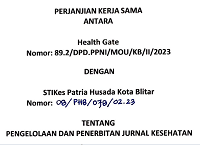Knowledge of School-Age Children About Mitigation of Mount Kelud Disaster
Abstract
Full Text:
PDFReferences
Indonesia. Undang-Undang Nomor 24 Tahun 2007 tentang Penanggulangan Bencana. Lembaran Negara RI Tahun 2007 Nomor 66, Tambahan Lembaran RI Nomor 4723. Sekretariat Negara. Jakarta
Kasengke, A., Khoirunisa, N., Uhan, K., Dasar, P., Daerah, D. Di, Bencana, R., & Tara, A. (2011). Arti Penting Pendidikan Mitigasi Bencana Dalam Mengurangi Resiko Bencana. Related papers Proseding Konferensi Nasional FPT PRB 2015, 174–187.
Irma Nadia Islamey, J., & Ayu Larasati Dian. (2020). Kajian Tingkat Kesiapsiagaan Masyarakat Dalam Menghadapi Bencana Letusan Gunung Kelud Pada Kawasan Rawan Bencana (Krb) Ii Di Desa Kebonrejo Kecamatan Kepung Kabupaten Kediri. Swara Bhumi, 1(1).
Indonesia. Undang-Undang Nomor 23 Tahun 2002 tentang Perlindungan Anak. Lembaran Negara RI Tahun 2002 Nomor 109, Tambahan Lembaran RI Nomor 4235. Sekretariat Negara. Jakarta
Darsini, D., Fahrurrozi, F., & Cahyono, E. A. (2019). Pengetahuan; Artikel Review. Jurnal Keperawatan, 12(1), 13.
Putra, A. W. S., & Podo, Y. (2017). Faktor-faktor yang mempengaruhi tingkat pengetahuan masyarakat dalam mitigasi bencana alam tanah longsor. Urecol 6th, 305–314.
Silalahi, E., Syarifuddin, S., & Sudibyo, M. (2016). Faktor-faktor yang Mempengaruhi Terhadap Pengetahuan Tentang Lingkungan pada Siswa Tingkat SMP/MTS N dan SMA/MAN Adiwiyata di Kota Labuhanbatu. Jurnal Pendidikan Biologi, 5(3), 146–153.
Indonesia. Undang-Undang Nomor 21 Tahun 2008 Tentang Penyelenggarakan Penanggulangan Bencana. Lembaran Negara RI Nomor 2008 Tahun 42, Tambahan Lembaran RI Nomor 4828. Sekretariat Negara. Jakarta
Suprajitno. (2016). Pengantar Riset Keperawatan. Pusdik SDM Kesehatan, Jakarta Selatan
Janna, N. M., & Herianto. (2021). Artikel Statistik yang Benar. Jurnal Darul Dakwah Wal-Irsyad (DDI), 18210047, 1–12.
DOI: https://doi.org/10.70111/hg1304
Refbacks
- There are currently no refbacks.
"Health Gate"
ISSN 2986-1098
Indexing:
Published by The Regional Leadership Council of the Indonesian National Nurses Association, Blitar City
Kalimantan Street, Kel.Karangtengah, Kec. Sananwetan, Blitar City, East Java, Indonesia


.png)








